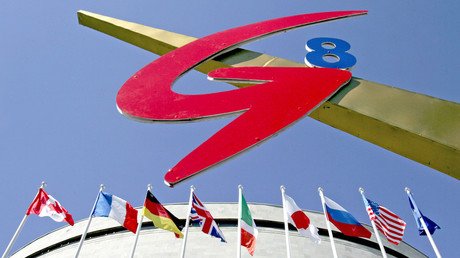105 hits in Syria? Not likely, says Russia & shows fragments of missiles downed in US-led strikes

The Russian Defense Ministry has shown fragments of missiles said to have been fired in the US-led April airstrikes in Syria. The hole-ridden remnants disprove the claim most of the 105 missiles hit their targets, it said.
On Wednesday, the Russian Defense Ministry held a media briefing to present its analysis of the missile attack on three sites in Syria by the US, UK and France on the night of April 13. It said evidence on the ground, including missile fragments, holes made by the warheads and damage to the targets, could positively confirm only 25 successful hits, calling the US claim of 105 missiles reaching their targets dubious.
Many of the missiles were intercepted by Syrian air defense, the ministry said, adding that some of the better-preserved fragments would be studied by Russian military engineers working on improving its anti-aircraft systems. Journalists have also been shown a collection of fragments with annotations to identify them as part of US and European missiles collected in Syria after being shot down.
The prime target for the night attack was said to be a research center northeast of Damascus, which Western nations claimed was a crucial part of Syria’s alleged chemical weapons industry. The center was targeted by 76 missiles, according to the Pentagon report on the operation. The Russian Defense Ministry said it could confirm only 13 hits and that, if one were to believe the Western report, the relatively small site should have been struck by eight tons of military-grade explosives. The damage caused is far less than one would expect from such a bombardment, Colonel General Sergey Rudskoy, the head of operations in the Russian general staff, pointed out.

Of the remaining 63 missiles, 46 are presumed intercepted by the Syrian air defense, the report said. The number is based on data collected from the weapon systems and the fragments collected in the five areas, where the interception took place. Rudskoy added that some of the missiles appear to have failed to reach their target due to a technical malfunction rather than interception, something which posed a threat to nearby residential areas. Two projectiles, a Tomahawk sea-launched cruise missile and a precision air-launched missile of a model not named by the ministry, were found in relatively undamaged condition and transported to Russia for further study, he said.


Rudskoy said the results of the attack on two other sites – military depots located near the city of Homs – were similar. One was reported as having been hit by 22 missiles, of which Russia could confirm only seven, with most of the damage done to auxiliary buildings rather than the depot targeted. The other was targeted by seven and hit by two missiles, the report said. The Syrian air defenses intercepted 20 missiles in the area, the general said, adding that most of the advanced weapons fired by the ad hoc coalition were nullified by Soviet air defense systems designed some four decades ago.


The Russian military has repeatedly said it was baffled as to why the US and its allies would target a site near Damascus, which they supposedly believed to be full of chemical weapons. If that were true, the release of the toxin from the damaged compound could have claimed tens of thousands of civilian lives, Rudskoy pointed out.
The ministry also showed off some of the weapons surrendered by militant groups as part of evacuation agreements with the government. The latest addition to the growing arsenal includes 28 tanks and 23 tactical missiles of the SCUD family, Rudskoy said. The militants also surrendered Western weapons, including TOW anti-tank missiles, he added.

If you like this story, share it with a friend!
















